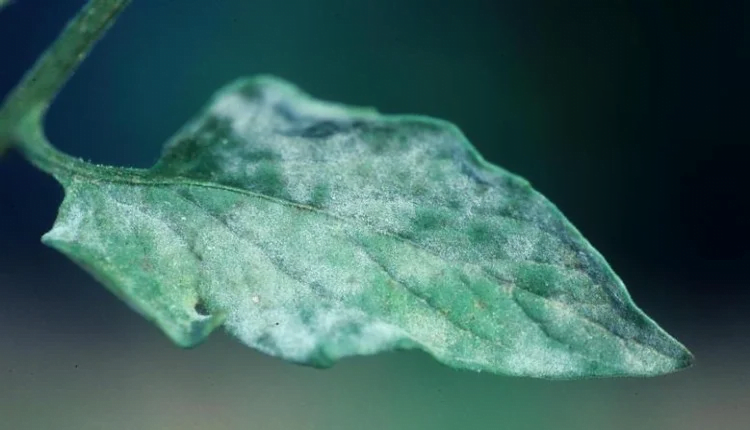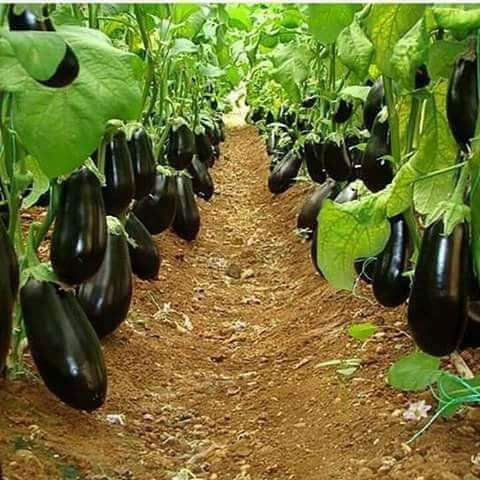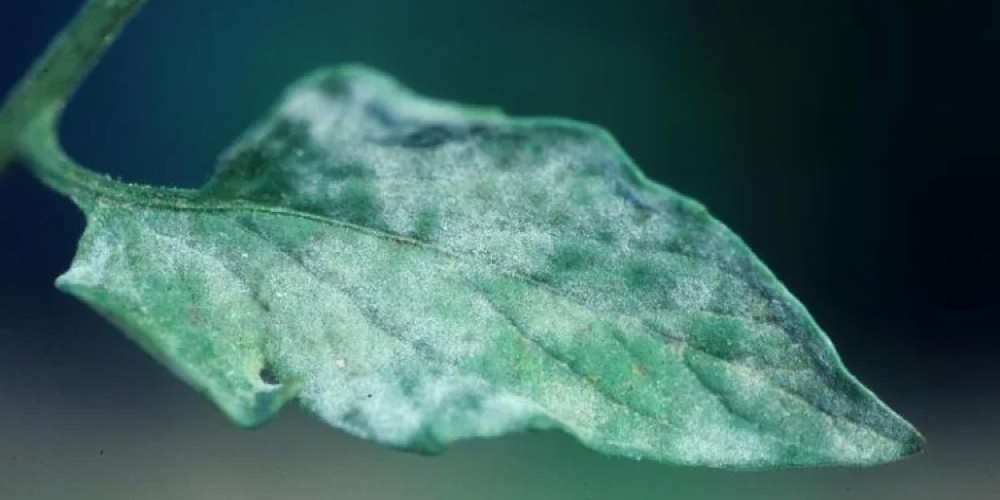Table of contents of the article
TogglePowdery mildew on eggplant is a common fungal disease that affects plant productivity and fruit quality. In this article from the “WORLD OF PLANTS” website, we discuss the symptoms of infection, the causes of powdery mildew on eggplant, and methods of effective prevention and control.
Symptoms of powdery mildew on eggplant
One of the symptoms of powdery mildew on eggplant is the yellow-brown spots that appear on the upper surface of the leaves, which are accompanied by white powdery growths in the form of granular powder on the lower surface. The way for a grower to know that it is powdery mildew is to observe white, powdery spots clustered around the undersurface of the affected leaf. The leaf is also deformed when the fungus infects the vessels at the edges, becoming shaped like a hooked spoon (so the symptoms are mixed with aphids). In addition, fungal growths covered with a white powder appear on the flowers and small fruits of the eggplant, which then dry up. Also, the fungus infects the fruits, and the infection appears in the form of spots that turn into what resemble white and brown skin scales and a powdery rash covering the eggplant fruits (which are not yet ripe).

Causes of powdery mildew on eggplant
There are factors that encourage powdery mildew infection on eggplant, and the most important factors are:
- High plant density per unit area between eggplant planting lines, and not planting at appropriate distances.
- Components of the fungus residing in the scales of buds and the cracks of fallen leaves from the eggplant plant on the surface of the soil.
- Transmission of spores from infected trees in nearby orchards, such as apples and citrus, to eggplant planting lines.
- The weather conditions, such as humidity and high temperature in the eggplant field, lead to infection with the fungus, as the fungus loves moisture.
- Also, the sensitivity of cultivated varieties plays a role in infection (eggplant varieties).
- Providing a warm and dry atmosphere in the eggplant field is considered the main reason for the infection of this fungus on the plant.
- The presence of wind, and the lack of windbreaks around eggplant fields, encourages infection because it transports conidial spores of the fungus.
The presence of other pests around the field that leads to infection (such as flies, borers, eggplant worms, etc.).- The weather conditions, such as humidity and high temperature in the eggplant field, lead to infection with the fungus, as the fungus loves moisture.
Dangers of powdery mildew on eggplant
.This fungus is a very dangerous disease and must be dealt with with pesticides and control if it occurs on eggplant. The crop may be damaged by 90% in some cases. This fungus is widespread in almost all agricultural environments around the world, as eggplant is grown in Ukraine, the Czech Republic, Austria, America, Canada, Brazil, Mexico, and East and West Asia, and it has a wide family range of plant families. This fungus affects eggplant cultivation and damage reaches 80% when the infection worsens.
The danger of powdery mildew on eggplant stems from the fact that it weakens the plant in areas of infection and encourages the emergence of new pests. The most important pests that may be attracted are boring pests, hoppers, tunnel makers, eggplant fruitworms, nutworms and leafworms. Agricultural pests can also interfere strongly with each other, forcing the farmer to apply an integrated agricultural pest control system in eggplant fields to protect them from fungi and other pests.
Control of powdery mildew on eggplant
Powdery mildew on eggplant is controlled through a number of preventive and curative measures
.
1. Preventive control of powdery mildew on eggplant
Preventive control is carried out by planting eggplant at appropriate distances, which are 40 cm between one plant and 45 cm between the lines, and spraying the eggplant leaves at the end of the season before falling, either with copper pesticides, or with urea. The farmer also takes care to get rid of the parts of the plant infected with the fungus and keep them completely away from the field (eggplant leaves and fruits). The farmer also takes care to carry out preventive pruning of the eggplant in order to ensure that it is not infected with other diseases, insect pests, etc. The farmer also gets rid of the weeds surrounding the field, and tries to reduce the air humidity in the field by reducing or regulating irrigation and not increasing it beyond the appropriate limit, and avoiding high plant density when planting eggplant.
2. Curative control of powdery mildew on eggplant
Therapeutic control is carried out as soon as the farmer identifies an actual harmful fungal infestation on the eggplant. Control is carried out using copper pesticides, or specialized systemic fungicides. When dealing with this fungus on eggplant, it is preferable to use pesticides related to terazol derivatives, strobilin derivatives, and carbamate derivatives. The farmer can use the pesticide Mancozeb, and he can also use the systemic pesticide carbendizim by spraying the leaves and fruits of eggplant. In addition, the farmer can control the fungus by using micronized sulfur with rimidine pesticides and spraying it on the affected fruits and leaves of eggplant. The farmer is keen to repeat the spraying two weeks after the first spraying, and the affected parts are collected and completely burned (eggplant leaves and fruits).
3. Episode of pesticide use against powdery mildew on eggplant
To avoid the fungus from developing resistant strains in infected eggplant fields and places of cultivation, a special pesticide cycle is used, where the pesticide Mancozeb is used in the first season of infection by spraying on the branches, leaves and fruits of eggplant infected with the fungus, especially the corroded ones. In the season following eggplant infection, the pesticide carbandizim is used by spraying on plants infected with the fungus and powdery growths, targeting leaves and branches, both old and young. While in the third season, the pesticide Dimethoate is accompanied by the pesticide Mancozeb by spraying on the eggplant plant on young and perennial branches, branches and leaves, and the same ring is changed after 9 years and new pesticides are used provided that they have the same properties and (the composition differs somewhat) and that they are safe - it is advised that It does not harm beneficial pollinating bees, enemies, or natural predators.
Integrated management procedures for powdery mildew on eggplant

Managing an eggplant field infected with the fungus
Integrated management of eggplant powdery mildew is resorted to when there are abundant insect pests in the field. What is meant by integrated management is the control measures mentioned previously, in addition to agricultural operations, taking care of the general condition of the plant along agricultural lines, and service operations such as hoeing, weeding, irrigation, and fertilizing. The environment, climatic conditions, humidity, temperature and other conditions are also taken care of and the eggplants are watered regularly without excess. The farmer prunes the plant well annually, and deep plows the soil in the eggplant fields to a depth of up to 40 cm before planting. The farmer also takes care not to increase the number of plowing times, and only three times per season for eggplants. In addition to that, the farmer takes care of the general condition of the plant, including irrigation, fertilization, weeding, and hoeing.
In conclusion, we would like to note that we, at the world of plants website, offer you all the necessary services in the world of plants, we provide all farmers and those interested in plants with three main services::-
- Artificial intelligence consulting service to help you identify diseases that affect plants and how to deal with them.
- Blog about plants, plant diseases and care of various crops ... You are currently browsing one of her articles right now.
- An application that provides agricultural consultations to clients, as well as a service for imaging diseases and knowing their treatment for free – Click to download the Android version from Google Play Store، Click to download the IOS version from the Apple App Store.
sources:-




